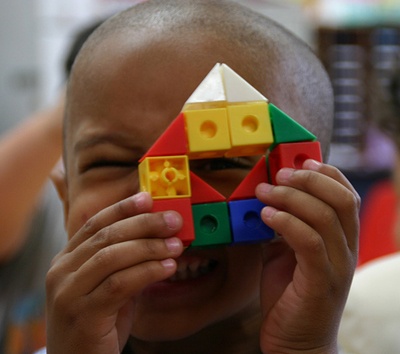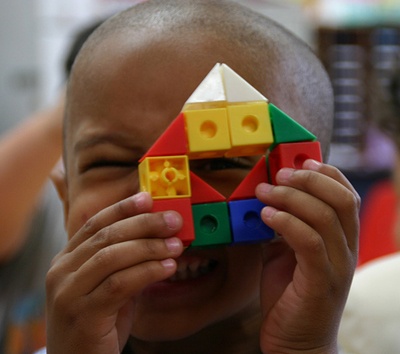A Closer Look: Early Intensive Behavioral Intervention (EIBI)
Overview
EIBI is a type of Applied Behavioral Analysis focused on children under five years of age. New research has shown that while intensive behavioral interventions work well with all children, children starting before the age of two were likely to make the most significant gains. For EIBI to be successful children are provided with 20 to 40 hours of one-on-one therapy and families are also incorporated into the process so that young children get as much exposure as possible.
How Does EIBI Work?
EIBI uses the principles of behavior analysis to increase positive and useful behaviors and decrease unwanted behaviors such as tantrums, aggression, and self-injury. It is a highly structured approach for teaching children under the age of five.

The core components of EIBI are:
- A teaching procedure called Discrete Trial Training
- A one-on-one adult to child environment
- 20-40 hours a week in a home or school setting for one to four years
- Oversight and program design by a professional
EIBI sessions are customized for each child’s skill level. A certified behavioral therapist works with the child and family to address specific behaviors that are carefully defined in observable terms, measured, and recorded to track the child’s development in learning, communication, self-care, and social competence. More complex tasks are broken down into easy to achieve units of behavior as the child develops skills.
A typical treatment schedule might be broken out into sections over the course of several years:
- Establish rapport (~two weeks)
- Foundational Skills (~2-6 months)
- Early Communicative Language (~6 months)
- Grammatical language and early socialization (~12 months)
- Socialization and School Entry (~12 months)
EIBI is often combined with other treatments such as speech therapy, group therapy, and occupational therapy.
What Does Recent Research Say?
Research conducted in 2014 found clear evidence demonstrating that toddlers with autism made significant gains in increasing desired behaviors and decreasing negative behaviors. Notably, the greatest gains were seen in children who started treatment programs before they were two-years-old. An earlier 2009 meta-analysis of studies also found encouraging evidence that EIBI is effective. These researchers strongly recommend EIBI for children with autism and encourage parents to start this treatment as early as possible.
While EIBI has an extensive track record of research indicating positive outcomes dating back to the 1960s, EIBI treatment has evolved a great deal since its inception and a large body of recent research supports its use. These two recent review studies mentioned above conclude that EIBI is one of the most effective approaches for young children with Autism:
Sigmund Eldevikabc, Richard P. Hastingsa, J. Carl Hughesa, Erik Jahrd, Svein Eikesethb & Scott Crosse (2009). “Meta-Analysis of Early Intensive Behavioral Intervention for Children With Autism.” Journal of Clinical Child & Adolescent Psychology, 38, no. 3.
Rebecca MacDonald, Diana Parry-Cruwys, Sally Dupere, William Ahearn (December 2014). “Assessing progress and outcome of early intensive behavioral intervention for toddlers with autism.” Research in Developmental Disabilities, 35, no. 12.
Resources for Parents
It is critical to find an experienced therapist with a proven track record, credentials, and dedication to service. A qualified professional needs to be involved in designing and supervising your child’s treatment program, though it might be a paraprofessional who will typically work one-on-one with your child. Choose a licensed clinical psychologist with training in Applied Behavior Analysis or a Behavior Analyst who is board certified by the Behavioral Analyst Certification Board and has experience working with children who have autism.
There is currently a high demand for ABA professionals, and some private practitioners claim to have ABA experience but, in fact, do not meet the minimum requirements established by BACB.
To locate a qualified practitioner:
- Ask your pediatrician for a recommendation.
- Check credentials of potential candidates including whether they have training and experience specific to autism and ABA/EIBI.
- Monitor and observe initial sessions with your child.
- Get involved in a support group and tap into resources recommended by other parents. (To find a support group see the National Autism Association.
- Work with someone who includes you and your family in the design of a treatment plan.
Early intervention services, including EIBI, are also available in every state for children under three years old who have developmental delays or disabilities including autism. Some of these services are free to qualified families. For more information about early intervention programs and services see the parentcenterhub.
- Autism Speaks Resource Guide provides a comprehensive list of treatment services in the United States including EIBI services.
Resources for Teachers:
Several studies, including a recent one in 2012 found that using EIBI in a preschool setting resulted in positive outcomes for children with autism. Preschool teachers can help with EIBI treatment and there are useful resources and programs available for learning EIBI skills as well as professional certification.
Several books provide information about the role of preschool teachers in helping children with autism by using EIBI.
Harris, S. L., & Handleman, J. S. (Eds.) (2001). Preschool education programs for children with autism (2nd ed., pp. 23-39). Austin, TX: Pro-Ed.
Harris, S.L., & Weiss, M.J. (2007). Right from the start: Behavioral intervention for young children with autism (2nd ed.). Bethesda, MD: Woodbine House.
Maurice, C., Green, G., & Foxx, R. (Eds.). (2001). Making a difference: Behavioral intervention for autism. Austin, TX: Pro-Ed.
Tools and resources for using EIBI in preschool can also be found on Stages Learning Materials' website:

L.F. Stebbins, M.Ed. M.L.I.S.
L.F. Stebbins has more than twenty-five years of experience in higher education with a background in library and information science, instructional design, research, and teaching. She has an M.Ed. from the Technology Innovation & Education Program at the Harvard Graduate School of Education and a Masters in Information Science from Simmons College. For twenty years she created and led media literacy and research skills programs for students and faculty at Brandeis University. Currently she is the Director at research4Ed.com and the Director for Research at Consulting Services for Education (CS4Ed). For more about Leslie visit LeslieStebbins.com.





